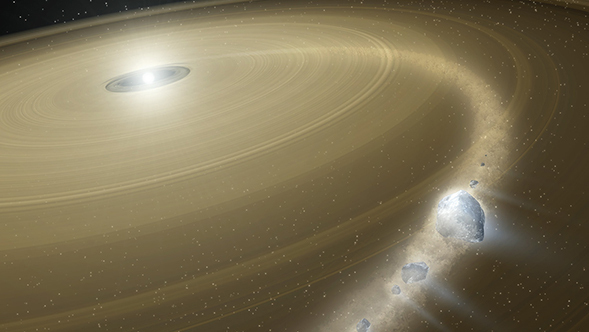
By Jay Farihi | May 29th, 2019
As a graduate student at the turn of the millennium, I will never forget a particular moment that caused my whole being to yell 'Stop the press!'. It changed the course of my career and led to a long-term love affair with NASA’s Spitzer Space Telescope. During a Q+A after a seminar related to star and planet formation, one of my advisors said something like 'We see heavy elements in some white dwarfs that shouldn't be there, maybe from infalling comets ...'. I stopped hearing the outside world at that very moment, and was frozen in space and time.
Did he really mean to say that something like comets were falling onto my precious white dwarfs? Those remnants of long-dead stars I slaved over for years? Those faint little stellar embers so favorable to cold companion detection, such as brown dwarfs (my thesis topic)? I was dumbstruck that bits of planetary pieces could conceivably fall onto white dwarfs, and was instantly hooked on this idea.
I was lucky: I was in the right place at the right time when Spitzer launched, and wanted to answer this question -- why were there heavy elements such as calcium, silicon, and iron on the surface of white dwarfs? Why had they not sunk down in the high gravity? There were two competing ideas at the time: dust and gas picked up from many revolutions around and through the Milky Way's spiral arms, or... bits of planet stuff! Believe it or not, the latter idea was controversial, especially in the white dwarf community. Funny how things turn out.
We used Spitzer over a few years to observe these 'dirty' white dwarfs that were externally polluted with heavy elements, and unambiguously identified dust and debris orbiting right on top of the stars. The material was right where it needed to be to fall onto the star and continuously give it 'metals' that should otherwise sink out of sight. Spitzer also showed us the orbiting material was very much like beach sand -- rich in silicate minerals. Puzzle solved; planet stuff!
That is not the whole story, and there have been some bumps and surprises over the years. Not all of these polluted stars reveal their debris disks, but we've used Spitzer to resolve this issue, finding there are more systems where the debris shows up faintly in the infrared than there are brighter infrared systems. So, most are “shy” --, if you like, just like the debris orbiting our Sun would be difficult to detect by alien astronomers who might be studying it from distant stars or planets.
Spitzer continues to surprise the community, and in the last few years it has shown us that these disks of planetary debris are changing at least annually if not more rapidly. The mysteries deepen, and as someone so indebted to Spitzer over the years, I can only hope it will continue its amazing legacy.

 Two Decades of 'Growing Up' with Spitzer
Two Decades of 'Growing Up' with Spitzer
 Spitzer's Final Voyage
Spitzer's Final Voyage



